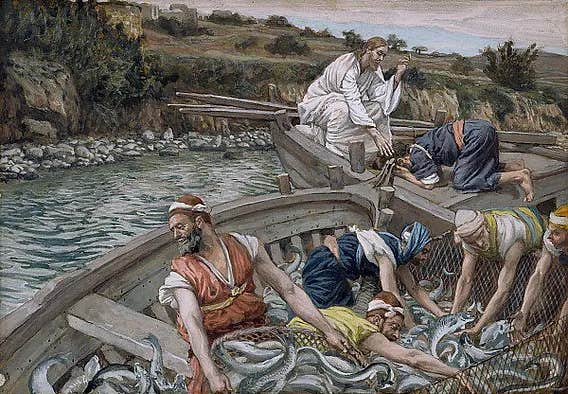Jesus’s ‘Miraculous Catch of Fish’ found to have a natural explanation
Study reveals that natural processes may explain the biblical fish miracles at Lake Kinneret, offering a fascinating look at faith and science

New research links biblical fish miracles at Lake Kinneret to natural phenomena like hypoxia and fish die-offs. (CREDIT: CC BY-SA 4.0)
Lake Kinneret, also known as the Sea of Galilee, holds a prominent place in both history and scripture. The lake, steeped in biblical narratives, is revered for its role in Jesus Christ’s ministry. Its shores were home to key moments like the Miracle of Loaves and Fishes and the Miraculous Catch of Fish.
For centuries, these accounts were seen as divine acts. However, recent scientific studies reveal that natural phenomena may underpin these biblical events.
The Miracles and Their Setting
Both miracles occurred along Lake Kinneret’s northwestern shore, near Tabgha.
The Miracle of Loaves and Fishes recounts how five loaves and two fish fed 5,000 people. In the Miraculous Catch of Fish, the apostles, following Jesus' advice, caught an unprecedented haul after a fruitless fishing night.
These narratives inspired centuries of faith and art, with mosaics and paintings depicting the events. A recent study in Water Resources Research, however, offers a compelling scientific explanation for these extraordinary episodes.
Stratification and Internal Waves
Lake Kinneret is a warm-monomictic lake, meaning it undergoes seasonal stratification. In summer, its warmer upper layer (epilimnion) sits above a cooler, oxygen-poor lower layer (hypolimnion), separated by a middle layer, the metalimnion. Wind plays a crucial role here, tilting the thermocline—the boundary between these layers—and triggering internal waves.
Related Stories
These waves, driven by seasonal winds, can last for hours or days. Researchers, including Antenucci and Imberger, have extensively studied such internal waves in Lake Kinneret. Their findings reveal that these waves sometimes cause water from the hypolimnion to upwell near the lake’s western shores, notably around Tabgha.
Hypoxia and Fish Die-Offs
The hypolimnion is anoxic, meaning it contains little to no oxygen. When upwelling occurs, this oxygen-depleted water rises to the surface, creating a deadly environment for fish. This phenomenon, known as hypoxia, leads to sudden fish die-offs.
In 2012, researchers documented two such events in May and June near Tabgha. Thousands of fish suffocated and floated to the surface. Similar occurrences were recorded in 2007 and the early 1990s, all in the same location. Such die-offs align closely with the biblical accounts, where large numbers of fish became easy to gather.
Linking Science to Scripture
Modern scientific tools like temperature sensors and dissolved oxygen monitors have provided crucial insights. These instruments showed how internal waves and wind-driven mixing disrupt Lake Kinneret’s oxygen balance. The result is a temporary abundance of surface fish, mimicking the biblical miracles.
The researchers noted, “Fish-kill events happen at the same location in the lake where the biblical Miracle of Loaves and Fishes and the Miraculous Catch of Fish occurred two millennia before.” They propose that Jesus’ miracles could have coincided with natural fish die-offs, giving the appearance of divine intervention.
Global Context
Lake Kinneret isn’t unique in experiencing hypoxia-induced fish kills. Similar events have been observed in Lake Erie, the Neuse River Estuary in North Carolina, and Canada’s Hamilton Harbor. Each location exhibits internal wave dynamics that temporarily bring anoxic waters to the surface, causing fish kills.
In Lake Erie, for instance, researchers used 3D modeling to simulate the internal wave field. Meanwhile, in Hamilton Harbor, intensive measurements of temperature and oxygen highlighted how internal waves impact aquatic life. These parallels reinforce the idea that such phenomena are well-documented and not restricted to Lake Kinneret.
Bridging Faith and Science
This study adds a new layer to understanding biblical miracles. While faith views these events as divine acts, science provides a natural explanation. The alignment of biblical accounts with documented fish kill events suggests a convergence of natural phenomena with historical narratives.
Researchers concluded, “[This] may explain the appearance of large numbers of easy-to-collect fish close to the shore described in the biblical narratives.” These findings don’t negate the spiritual significance of the miracles but rather offer a lens to view them through the intersection of faith and science.
Implications for Biblical Timelines
The study also helps pinpoint when these events might have occurred. Fish die-offs typically happen in late spring or early summer, during periods of thermal stratification. This seasonal timing aligns with the biblical narratives, suggesting that Jesus’ miracles may have coincided with naturally occurring phenomena.
The researchers emphasize that while the exact timing remains speculative, the scientific explanation provides context for understanding how these miracles could have unfolded in real time.
Lake Kinneret continues to be a site where history, faith, and science intersect. The recent study offers a plausible explanation for the biblical fish miracles, showing how natural processes could create extraordinary events. This fusion of ancient narrative and modern science enriches our understanding of one of the world’s most storied bodies of water.
Note: Materials provided above by The Brighter Side of News. Content may be edited for style and length.
Like these kind of feel good stories? Get The Brighter Side of News' newsletter.
Joseph Shavit
Head Science News Writer | Communicating Innovation & Discovery
Based in Los Angeles, Joseph Shavit is an accomplished science journalist, head science news writer and co-founder at The Brighter Side of News, where he translates cutting-edge discoveries into compelling stories for a broad audience. With a strong background spanning science, business, product management, media leadership, and entrepreneurship, Joseph brings a unique perspective to science communication. His expertise allows him to uncover the intersection of technological advancements and market potential, shedding light on how groundbreaking research evolves into transformative products and industries.



